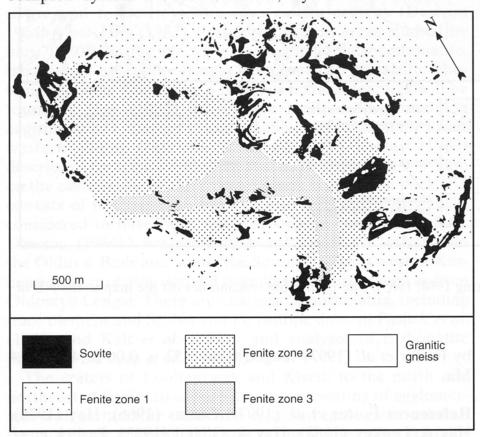stripes
Over and around the low, rounded summit of Oldoinyo Dili Usagaran granitic gneisses have been penetrated by a complex system of sovite sheets, dykes and veins. The gneisses have been fenitized and McKie (1966) has distinguished three fenite zones, but it is apparent from his map that the highest grades of fenitization do not correspond to the highest concentration of sovite - at the present erosion level. The sovites display steeply dipping mineral banding parallel to contacts and consist of calcite (60-96%) and, particularly in the marginal zones, aegirine-augite, biotite and occasional sodic amphibole; accessories include pyrochlore, magnetite, apatite and fluorite. Fenite xenoliths are rimmed by biotite. Two dykes, one of tinguaite the other of alvikitic alnoite, have been recognised; there are apparently no other intrusive rock types. Fenitization of the granite gneiss first manifests itself by the development of oligoclase-albite and fine-grained aggregates and needles of magnesioarfvedsonite, which may grow at the expense of biotite. In the second stage quartz loses signs of strain, there is more oligoclase-albite, orthoclase cryptoperthite appears, and there is some replacement of quartz by feldspar. Acicular aegirine and bladed magnesioarfvedsonite form veins. At the next stage quartz disappears and microcline-microperthite is replaced by orthoclase-cryptoperthite and twinned albite is usually present; aegirine is coarser and more abundant and amphibole forms independent areas. Fenite xenoliths in the carbonatite are distinguished by being rimmed by biotite, but there is also abundant biotite and irregular patches of calcite throughout the rock. McKie's (1966) account of the Oldoinyo Dili fenites is supported by analyses of rocks, biotite, magnesioarfvedsonite and sodic pyroxene and chemical and crystallographic data on feldspars.
MCKIE, D. 1966. Fenitization. In: O.F. Tuttle and J. Gittins (eds) Carbonatites, 261-94. John Wiley, New York.

